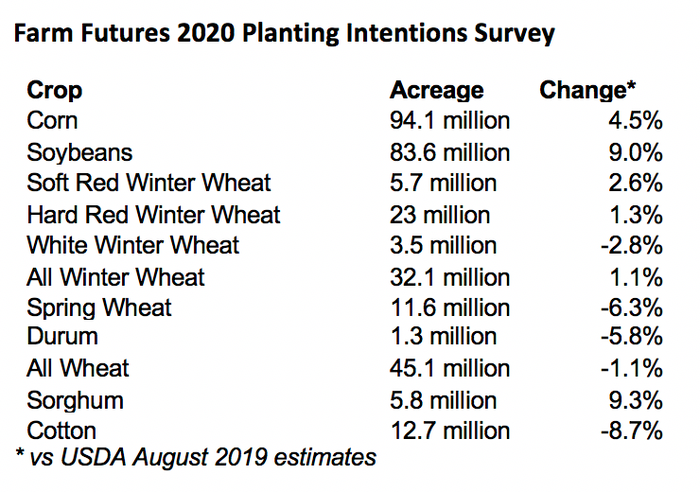
Farmers plan to plant more corn, soybeans and wheat in the coming year after historic flooding in 2019 prevented planting on record acreage. But Farm Futures first survey of 2020 planting intentions shows not all of the lost ground may go back into traditional row crops.
To be sure, this first look at plans for the coming spring is highly subject to change, depending on weather and markets. But the survey suggests the fallout from trade wars and weather woes may not heal completely next year, with intentions for major crop seedings still 4.7 million acres below 2018 levels.
Farmers said they hope to plant 94.1 million acres of corn, up 4.5 % from the 90 million USDA said they planted in its Aug. 12 report on production. But the Farm Futures survey was completed one week before that surprise result sent prices sharply lower.
Low prices and bad weather caused farmers to slash soybean seedings by 14% in 2019, to 76.7 million acres. Growers told Farm Futures they hope to boost that total back to 83.6 million next spring, an increase of 9%. But that would still be 5.6 million acres below the 89.2 million farmers put in for harvest in 2018. Low prices and uncertainty about Chinese demand could keep farmers cautious.
While corn and soybean decisions don’t have to be made for months, farmers will begin seeding next year’s winter wheat crop soon. Abundant moisture on parts of the Plains has producers ready to boost hard red winter wheat seedings 1.3% to 23 million acres despite lower prices. Soft red winter wheat could also see gains with white wheat lower, taking total winter crop seedings this fall up 1.1% to 32.1 million. But those hopes in part depend on farmers being able to harvest fall crops in time for drills to roll.
Farmers to the north were less optimistic about acreage, expecting to cut plantings of spring wheat and durum in 2020. Overall wheat acreage could be down 1.1% to 45.1 million, which would be 2.7 million below 2018.
Two other crops impacted by Chinese tariffs could also see changes in 2020. Lower prices and a growing U.S. surplus could convince farmers in the South and West to cut cotton seedings 8.7% to 12.7 million acres next spring after only a small reduction this year. Sorghum, one of the first grain exports to feel the sting of Chinese trade actions, could gain back 9.3% to 5.8 million acres, which also would be higher than planted in 2018.
While the Farm Futures survey showed lower plantings of these major crops, that doesn’t mean producers plan to let ground sit idle. Farmers said they will boost acreage devoted to other crops to return total seedings back to or above 2018 levels.
Farm Futures surveyed more than 1,150 farmers July 21 to Aug. 3. Growers were invited by email to provide information through an online survey. Results of the survey are released annually on the first day of the Farm Progress Show, taking place this year Aug. 27-29 in Decatur, IL.

About the Author(s)
You May Also Like






